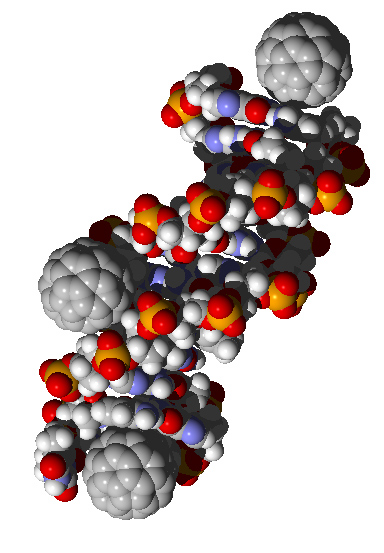Manufactured Nanoparticles Might Pose Health Threat

Buckyballs, among the most used and certainly the most celebrated of manmade nanoparticles, might represent a potent health threat.
According to computer simulations the 60-carbon-atom, soccer-ball-shaped molecule can damage or even destroy DNA.
Researchers have suggested that buckyballs, whose technical name is "fullerenes," might be used in chemical sensors and hydrogen fuel cells. And some researchers are testing biomedical applications in which buckyballs would encapsulate especially toxic drugs or radioactive materials.
Scientists already realized buckyballs could be toxic. Studies at Duke University in 2004 showed that when buckyballs were introduced to laboratory aquariums they damaged the brains of largemouth bass and may also have prevented certain water-borne bacteria from reproducing.
Until then scientists had theorized that the strong attraction that buckyballs have for each other would cause the molecules to clump together and safely sink to the bottom of any body of water, be it a test aquarium or a lake.
As it turns out, says Peter Cummings, a professor of chemical engineering at Vanderbilt University and director of the Oak Ridge National Laboratory's Nanomaterials Theory Institute, in water the attraction between a buckyball molecule and a DNA molecule is several times stronger than the attraction between two buckyballs.
"We found, somewhat surprisingly, that these buckyballs bond quite strongly to both double-stranded and single-stranded DNA," said Cummings, whose group designed the simulation. "They bond strongly enough that they distort the structure of the DNA."
Sign up for the Live Science daily newsletter now
Get the world’s most fascinating discoveries delivered straight to your inbox.
The buckyballs break apart vital hydrogen bonds within the DNA molecule's double helix and they can stick to grooves on DNA's surface, causing the molecule to bend. Not only do the buckyballs damage the DNA, Cummings says, they cripple its ability to heal.
"The buckyballs insert themselves in a way that prevents the DNA from self-repairing," Cummings told LiveScience. The buckyball actually forces a piece of nucleotide from one of the DNA's double helixes and takes its place, preventing the strands from reuniting.
Cummings cautions that this simulation work didn't test whether buckyballs can breach the cell walls that house DNA molecules. That would require another simulation project and, eventually, laboratory tests on living organisms. And, he notes, these results don't mean that all nano-scale building blocks pose such threats.
- Nanotechnology May Need Regulation
- Gold Probes Could Reveal Cancer in Your Body
- Chemotherapy 'Bomb' Developed in Cancer War
- Gallery: Micromachines










